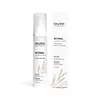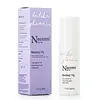What's inside
What's inside
 Key Ingredients
Key Ingredients

 Benefits
Benefits

 Concerns
Concerns

 Ingredients Side-by-side
Ingredients Side-by-side

Water
Skin ConditioningGlycerin
HumectantCoco-Caprylate/Caprate
EmollientCetyl Alcohol
EmollientCetearyl Alcohol
EmollientGlyceryl Stearate
EmollientPanthenol
Skin ConditioningStearic Acid
CleansingTocopheryl Acetate
AntioxidantGlycine Soja Oil
EmollientRetinol
Skin ConditioningHyaluronic Acid
HumectantHydrolyzed Hyaluronic Acid
HumectantSodium Hyaluronate
HumectantCitrus Aurantium Amara Flower Extract
RefreshingJasminum Officinale Flower Extract
MaskingLavandula Angustifolia Flower Extract
CleansingPaeonia Officinalis Flower Extract
TonicPrunus Serrulata Flower Extract
Skin ConditioningSambucus Nigra Flower Extract
RefreshingRosa Damascena Flower Oil
MaskingHelianthus Annuus Seed Oil
EmollientHydrolyzed Glycosaminoglycans
HumectantSodium Hyaluronate Crosspolymer
HumectantPropanediol
SolventRaspberry Ketone
MaskingCitric Acid
BufferingPolysorbate 20
EmulsifyingEthylhexylglycerin
Skin ConditioningBenzyl Glycol
SolventSodium Lauroyl Glutamate
Dehydroacetic Acid
PreservativeBenzyl Alcohol
PerfumingWater, Glycerin, Coco-Caprylate/Caprate, Cetyl Alcohol, Cetearyl Alcohol, Glyceryl Stearate, Panthenol, Stearic Acid, Tocopheryl Acetate, Glycine Soja Oil, Retinol, Hyaluronic Acid, Hydrolyzed Hyaluronic Acid, Sodium Hyaluronate, Citrus Aurantium Amara Flower Extract, Jasminum Officinale Flower Extract, Lavandula Angustifolia Flower Extract, Paeonia Officinalis Flower Extract, Prunus Serrulata Flower Extract, Sambucus Nigra Flower Extract, Rosa Damascena Flower Oil, Helianthus Annuus Seed Oil, Hydrolyzed Glycosaminoglycans, Sodium Hyaluronate Crosspolymer, Propanediol, Raspberry Ketone, Citric Acid, Polysorbate 20, Ethylhexylglycerin, Benzyl Glycol, Sodium Lauroyl Glutamate, Dehydroacetic Acid, Benzyl Alcohol
Ingredients Explained
These ingredients are found in both products.
Ingredients higher up in an ingredient list are typically present in a larger amount.
Ethylhexylglycerin (we can't pronounce this either) is commonly used as a preservative and skin softener. It is derived from glyceryl.
You might see Ethylhexylglycerin often paired with other preservatives such as phenoxyethanol. Ethylhexylglycerin has been found to increase the effectiveness of these other preservatives.
Glycerin is already naturally found in your skin. It helps moisturize and protect your skin.
A study from 2016 found glycerin to be more effective as a humectant than AHAs and hyaluronic acid.
As a humectant, it helps the skin stay hydrated by pulling moisture to your skin. The low molecular weight of glycerin allows it to pull moisture into the deeper layers of your skin.
Hydrated skin improves your skin barrier; Your skin barrier helps protect against irritants and bacteria.
Glycerin has also been found to have antimicrobial and antiviral properties. Due to these properties, glycerin is often used in wound and burn treatments.
In cosmetics, glycerin is usually derived from plants such as soybean or palm. However, it can also be sourced from animals, such as tallow or animal fat.
This ingredient is organic, colorless, odorless, and non-toxic.
Glycerin is the name for this ingredient in American English. British English uses Glycerol/Glycerine.
Learn more about GlycerinWater. It's the most common cosmetic ingredient of all. You'll usually see it at the top of ingredient lists, meaning that it makes up the largest part of the product.
So why is it so popular? Water most often acts as a solvent - this means that it helps dissolve other ingredients into the formulation.
You'll also recognize water as that liquid we all need to stay alive. If you see this, drink a glass of water. Stay hydrated!
Learn more about Water